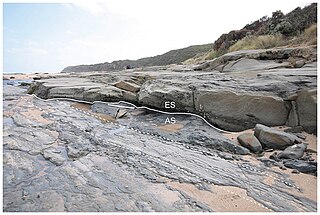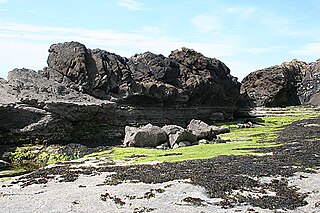
The Oxford Clay is a Jurassic marine sedimentary rock formation underlying much of southeast England, from as far west as Dorset and as far north as Yorkshire. The Oxford Clay Formation dates to the Jurassic, specifically, the Callovian and Oxfordian ages, and comprises two main facies. The lower facies comprises the Peterborough Member, a fossiliferous organic-rich mudstone. This facies and its rocks are commonly known as lower Oxford Clay. The upper facies comprises the middle Oxford Clay, the Stewartby Member, and the upper Oxford Clay, the Weymouth Member. The upper facies is a fossil poor assemblage of calcareous mudstones.

Szechuanosaurus is an extinct genus of carnivorous theropod dinosaur from the Late Jurassic. Fossils referred to the genus have been found in China, Asia in the Oxfordian-?Tithonian. Its type species is based on several undiagnostic teeth from the Kuangyuan Series. Additional possible specimens of Szechuanosaurus were also reported from the Kalaza Formation, also located in China.

The Kimmeridge Clay is a sedimentary deposit of fossiliferous marine clay which is of Late Jurassic to lowermost Cretaceous age and occurs in southern and eastern England and in the North Sea. This rock formation is the major source rock for North Sea oil. The fossil fauna of the Kimmeridge Clay includes turtles, crocodiles, sauropods, plesiosaurs, pliosaurs and ichthyosaurs, as well as a number of invertebrate species.

Kelmayisaurus is an extinct genus of carcharodontosaurid theropod dinosaur from the Early Cretaceous. It was roughly 10–12 meters long and its name refers to the petroleum-producing city of Karamay in the Xinjiang province of western China near where it was found.

Stephen Louis Brusatte is an American paleontologist and evolutionary biologist who specializes in the anatomy and evolution of dinosaurs. He was educated at the University of Chicago for his Bachelors degree, at the University of Bristol for his Master's of Science on a Marshall Scholarship, and finally at the Columbia University for Master's in Philosophy and Doctorate. He is currently a Reader in Vertebrate Palaeontology at the University of Edinburgh.

The Inferior Oolite is a sequence of Jurassic age sedimentary rocks in Europe. It was deposited during the Middle Jurassic. The Inferior Oolite Group as more recently defined is a Jurassic lithostratigraphic group in southern and eastern England. It has been variously known in the past as the Under Oolite, the Inferior Oolite, the Inferior Oolite Series and the Redbourne Group.

The Eumeralla Formation is a geological formation in Victoria, Australia whose strata date back to the Early Cretaceous. It is Aptian to Albian in age. Dinosaur remains are among the fossils that have been recovered from the formation, particularly from the Dinosaur Cove locality.
The Broadford Beds Formation is a Sinemurian geologic formation in western Scotland. An indeterminate partial tibia of a theropod dinosaur are among the fossils that have been recovered from the formation
The Reuchenette Formation is a Jurassic geologic formation in Switzerland. It is Kimmeridgian in age and predominantly consists of well stratified limestone, with lithology variable both laterally and stratigraphically including wackestones, packstones and grainstones, as well as mudstone. Dinosaur remains are among the fossils that have been recovered from the formation, including the Turiasaurian sauropod Amanzia greppini, alongside a theropod tooth belonging to Ceratosauria indet, originally assigned to Megalosaurus meriani. teleosaurid crocodyliformes are also known, including Sericodon, Proexochokefalos and Machimosaurus. The thalassochelydian turtle Solnhofia is known from the formation, as is the platychelyid turtle Platychelys.

The Valtos Sandstone Formation is a Middle Jurassic (Bathonian) formation found in the Inner Hebrides of Scotland. It is the thickest member of the Great Estuarine Group. The lithology consists of sets of approximately 6 metre thick cross bedded sandstone, capped by thin shelly limestones containing bivalves of the genus Neomiodon Dinosaur remains are among the fossils that have been recovered from the formation, although none have yet been referred to a specific genus.
The Tereñes Formation or Tereñes Marl is a Late Jurassic (Kimmeridgian) geologic formation in Asturias, Spain. The grey marls of the formation were deposited in a lagoonal environment at a muddy coast along a temporary inland sea. The lower section of the formation comprises silty and chalky sandstones with desiccation cracks and ripple marks, then becomes a bituminous, prominently ostracod-bearing, pelecypod shell chalk, lime chalk marl and marl. Fossil tracks have been reported from the formation.
The Irhazer Shale or Irhazer II Formation is a Middle Jurassic geologic formation of the Irhazer Group in the Agadez Region of Niger. Fossil ornithopod tracks have been reported from the formation. The dinosaur Spinophorosaurus is known from the formation.

The Great Estuarine Group is a sequence of Middle Jurassic sedimentary rocks deposited in the Inner Hebrides of Scotland. The sedimentary sequence was originally named the 'Great Estuarine Series' by geologist John Wesley Judd in 1878. Sedimentary outcrops occur on Skye, Raasay, Eigg and Muck. It comprises a series of shales, clays, silts, mudstones, and sandstones deposited in two drainage basins: the Inner Hebrides basin and the Sea of the Hebrides basin. The sediments are equivalent in age to the Inferior and Great Oolite Groups found in southern England.

The Bearreraig Sandstone Formation is a geological formation in Scotland. It preserves fossils dating back to the lower to middle parts of the Jurassic period (Toarcian–Bajocian). The remains of the proximal portion of a right ulna and radius of an indeterminate thyreophoran dinosaur are known from the formation. The ichthyosaur Dearcmhara is also known from the formation.

The Duntulm Formation is a sedimentary geologic formation deposited in the Inner Hebrides, Scotland. The formation was previously known as the 'Lower Ostrea Beds', and dates to the Bathonian stage of the Middle Jurassic. The formation is noted for its highly fossiliferous oyster beds, which compose of the species Praeexogyra hebridica. The sedimentary sequence also forms part of the Great Estuarine Group.

The Kilmaluag Formation is a Middle Jurassic geologic formation in Scotland. It was formerly known as the Ostracod Limestone for preserving an abundance of fossil freshwater/low salinity ostracods. Gastropods, bivalves, trace fossil burrows, and vertebrate fossil remains have also been recorded from the formation. Vertebrate fossils include fish, crocodylomorphs, mammals, small reptiles, amphibians, theropod and sauropod dinosaurs and pterosaurs.
Dearcmhara is a genus of marine reptile from the early to mid-Jurassic period around 170 million years ago, known from fossil remains found on the island of Skye in Scotland. The type species is Dearcmhara shawcrossi. Fragmentary fossil remains of the animal were discovered by an amateur fossil hunter in 1959 and were subsequently donated to a museum, but it was not until 2014 that a scientific research project determined that the fossils were of a previously unknown species.
Nicholas Campbell Fraser, known as Nicholas C. Fraser, is a British palaeontologist, academic, and museum curator. He specialises in the Triassic period and vertebrate palaeontology. Since 2007, he has been Keeper of Natural Sciences at the National Museums Scotland. He has been adjunct professor of geology at Virginia Tech since 1993 and at North Carolina State University since 2007.

Dearc is a genus of large-bodied rhamphorhynchine pterosaur from the Middle Jurassic Lealt Shale Formation of Scotland. The holotype, a juvenile or subadult that was still actively growing, has an estimated wingspan of 2.5 to 3 meters, making it the largest flying animal of its time. This pushes the origin of large pterosaurs back significantly, as it was previously assumed that pterosaurs did not reach greater body sizes until the short-tailed pterodactyloid lineages of the Cretaceous. The genus contains a single species, Dearc sgiathanach ( ).













